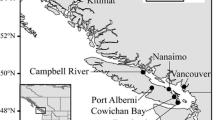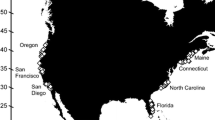Abstract
To assess the potential of domestic traffic for the regional spread of nonindigenous species (NIS), we surveyed the hull of an oceanographic vessel serving routes in the southwestern Atlantic and Southern Ocean. Sampling was performed while the vessel was in the water and in dry-dock in the Port of Mar del Plata, Argentina. We found 120 taxa belonging to 14 different invertebrate groups, including 53 species, 47 morphospecies, and 20 taxa identified at higher taxonomic levels. Ten of these species have not been reported for the Port of Mar del Plata and adjacent areas prior to the present study, and eight are new records for the entire Argentine coast. While both in-water and dry-dock sampling allowed for the detection of native, non-native, and cryptogenic fauna, more samples and species were obtained in dry-dock. Dry-dock richness estimates amounted to up to ~ 110 hull fouling species. Despite specific logistic challenges, dry-dock sampling should be considered by managers assessing vector strength due to its greater species detection power. The present results highlight the potential for domestic vessel spread of hull fouling marine NIS, and pinpoint likely future additions to the non-native fauna inventory in the southwestern Atlantic.



Similar content being viewed by others
References
Ammon, U., L. Swift, S. Brand, A. Jeffs, S. Swift & B. Dunphy, 2018. Review of in-water hull encapsulation and enclosure treatments for eliminating marine biofouling. Technical Report, Ministry for Primary Industries, New Zealand Government.
Brine, O., L. Hunt & M. J. Costello, 2013. Marine biofouling on recreational boats on swing moorings and berths. Management of Biological Invasions 4: 327–341.
Brunetti, R., C. Gissi, R. Pennati, F. Caicci, F. Gasparini & L. Manni, 2015. Morphological evidence that the molecularly determined Ciona intestinalis type A and type B are different species: Ciona robusta and Ciona intestinalis. Journal of Zoological Systematics and Evolutionary Research 53: 186–193.
Brunetti, R., L. Manni, F. Mastrototaro, C. Gissi & F. Gasparini, 2017. Fixation, description and DNA barcode of a neotype for Botryllus schlosseri (Pallas, 1766) (Tunicata, Ascidiacea). Zootaxa 4353: 29–50.
Carlton, J. T., 1996. Biological invasions and cryptogenic species. Ecology 77: 1653–1655.
Carlton, J. T. & J. Hodder, 1995. Biogeography and dispersal of coastal marine organisms: experimental studies on a replica of a 16th-century sailing vessel. Marine Biology 121: 721–730.
Castro, M. C. T. D., T. W. Fileman & J. M. Hall-Spencer, 2017. Invasive species in the Northeastern and Southwestern Atlantic Ocean: A review. Marine Pollution Bulletin 116: 41–47.
Castro, K. L., C. B. Giachetti, N. Battini, A. Bortolus & E. Schwindt, 2020. Cleaning by beaching: introducing a new alternative for hull biofouling management in Argentina. Aquatic Invasions 15: 63–80.
Chao, A. & T.-J. Shen, 2010. Program SPADE (Species Prediction and Diversity Estimation). Program and User’s Guide. http://chao.stat.nthu.edu.tw.
Chao, A., K. H. Ma & T. C. Hsieh, 2016. iNEXT (iNterpolation and EXTrapolation) Online: Software for Interpolation and Extrapolation of Species Diversity. Program and User’s Guide. http://chao.stat.nthu.edu.tw/wordpress/software_download/.
Clarke Murray, C., E. A. Pakhomov & T. W. Therriault, 2011. Recreational boating: a large unregulated vector transporting marine invasive species. Diversity and Distributions 17: 1161–1172.
Clarke Murray, C., T. W. Therriault & E. Pakhomov, 2013. What lies beneath? An evaluation of rapid assessment tools for management of hull fouling. Environmental Management 52: 374–384.
Coutts, A. D. M. & T. J. Dodgshun, 2007. The nature and extent of organisms in vessel sea-chests: a protected mechanism for marine bioinvasions. Marine Pollution Bulletin 54: 875–886.
Coutts, A. D. M. & M. D. Taylor, 2004. A preliminary investigation of biosecurity risks. New Zealand Journal of Marine and Freshwater Research 38: 215–229.
Coutts, A. D. M., R. F. Piola, M. D. Taylor, C. L. Hewitt & J. P. A. Gardner, 2010. The effect of vessel speed on the survivorship of biofouling organisms at different hull locations. Biofouling 26: 539–553.
Davidson, I. C., L. D. McCann, P. W. Fofonoff, M. D. Sytsma & G. M. Ruiz, 2008. The potential for hull-mediated species transfers by obsolete ships on their final voyages. Diversity and Distributions 14: 518–529.
Davidson, I. C., C. W. Brown, M. D. Sytsma & G. M. Ruiz, 2009. The role of containerships as transfer mechanisms of marine biofouling species. Biofouling 25: 645–655.
Drake, J. M. & D. M. Lodge, 2007. Hull fouling is a risk factor for intercontinental species exchange in aquatic ecosystems. Aquatic Invasions 2: 121–131.
Farinati, E. A., 1985. Paleontología de los sedimentos marinos holocenos de los alrededores de Bahía Blanca, Provincia de Buenos Aires. Ameghiniana 21: 211–222.
Floerl, O. & A. D. M. Coutts, 2013. Feasibility of using remote-operated vehicles (ROVs) for vessel biofouling inspections. Fisheries Occasional Publication 117: 54.
Frey, M. A., N. Simard, D. D. Robichaud, J. L. Martin & T. W. Therriault, 2014. Fouling around: vessel sea-chests as a vector for the introduction and spread of aquatic invasive species. Management of Biological Invasions 5: 21–30.
Gollasch, S., 2002. The importance of ship hull fouling as a vector of species introductions into the North Sea. Biofouling 18: 105–121.
Gotelli, N. J. & R. K. Colwell, 2001. Quantifying biodiversity: procedures and pitfalls in the measurement and comparison of species richness. Ecology Letters 4: 379–391.
Gotelli, N. J. & R. K. Colwell, 2011. Estimating species richness. In Magurran, A. E. & B. J. McGill (eds.), Biological Diversity. Frontiers in Measurement and Assessment. Oxford University Press, Oxford: 39–54.
Hsieh, T. C., K. H. Ma & A. Chao, 2016. iNEXT: an R package for rarefaction and extrapolation of species diversity (Hill numbers). Methods in Ecology and Evolution 7: 1451–1456.
Kalaci, O., 2011. Hull fouling as an invasion vector: comparison of in-water and dry-dock sampling methods. Honors Thesis, University of Windsor, Canada.
Kelly, N. E., K. Wantola, E. Weisz & N. D. Yan, 2013. Recreational boats as a vector of secondary spread for aquatic invasive species and native crustacean zooplankton. Biological Invasions 15: 509–519.
López-Legentil, S., M. L. Legentil, P. M. Erwin & X. Turon, 2015. Harbor networks as introduction gateways: contrasting distribution patterns of native and introduced ascidians. Biological Invasions 17: 1623–1638.
Martínez-Laiz, G., A. Ulman, M. Ros & A. Marchini, 2019. Is recreational boating a potential vector for non-indigenous peracarid crustaceans in the Mediterranean Sea? A combined biological and social approach. Marine Pollution Bulletin 140: 403–415.
Marchini, A., B. S. Galil & A. Occhipinti-Ambrogi, 2015. Recommendations on standardizing lists of marine alien species: lessons from the Mediterranean Sea. Marine Pollution Bulletin 101: 267–273.
McCollin, T. & L. Brown, 2014. Native and non native marine biofouling species present on commercial vessels using Scottish dry docks and harbours. Management of Biological Invasions 5: 85–96.
Nishikawa, T., I. Oohara, K. Saitoh, Y. Shigenobu, N. Hasegawa, M. Kanamori, K. Baba, X. Turon & J. D. D. Bishop, 2014. Molecular and morphological discrimination between an invasive ascidian, Ascidiella aspersa, and its congener A. scabra (Urochordata: Ascidiacea). Zoological Science 31: 180–185.
Orensanz, J. M., E. Schwindt, G. Pastorino, A. Bortolus, G. Casas, G. Darrigran, R. Elías, J. López Gappa, S. Obenat, M. Pascual, P. Penchaszadeh, M. L. Piriz, F. Scarabino, E. D. Spivak & E. A. Vallarino, 2002. No longer the pristine confines of the world ocean: a survey of exotic marine species in the southwestern Atlantic. Biological Invasions 4: 115–143.
Pérez-Portela, R., V. Arranz, M. Rius & X. Turon, 2013. Cryptic speciation or global spread? The case of a cosmopolitan marine invertebrate with limited dispersal capabilities. Scientific Reports 3: 1–10.
Peters, K., K. J. Sink & T. B. Robinson, 2019. Sampling methods and approaches to inform standardized detection of marine alien fouling species on recreational vessels. Journal of Environmental Management 230: 159–167.
Pysek, P., D. M. Richardson, M. Rejmanek, G. L. Webster, M. Williamson & J. Kirschnerl, 2004. Alien plants in checklists and floras: towards better communication between taxonomists and ecologists. Taxon 53: 131–143.
Ruiz, G. M., P. W. Fofonoff, B. P. Steves & J. T. Carlton, 2015. Invasion history and vector dynamics in coastal marine ecosystems: a North American perspective. Aquatic Ecosystem Health and Management 18: 299–311.
Rumbold, C., M. Meloni, B. Doti, N. Correa, M. Albano, F. Sylvester & S. Obenat, 2018. Two new nonindigenous isopods in the Southwestern Atlantic: simultaneous assessment of population status and shipping transport vector. Journal of Sea Research 138: 1–7.
Rup, M. P., S. A. Bailey, C. J. Wiley, M. S. Minton, A. W. Miller, G. M. Ruiz & H. J. MacIsaac, 2010. Domestic ballast operations on the Great Lakes: potential importance of Lakers as a vector for introduction and spread of nonindigenous species. Canadian Journal of Fisheries and Aquatic Sciences 67: 256–268.
Schwindt, E. & A. Bortolus, 2017. Aquatic invasion biology research in South America: geographic patterns, advances and perspectives. Aquatic Ecosystem Health & Management 20: 322–333.
Schwindt, E., J. T. Carlton, J. M. Orensanz, F. Scarabino & A. Bortolus, 2020. Past and future of the marine bioinvasions along the Southwestern Atlantic. Aquatic Invasions 15: 1–19.
Schwindt, E., J. López Gappa, M. P. Raffo, M. Tatián, A. Bortolus, J. M. Orensanz, G. Alonso, M. E. Diez, B. Doti, G. Genzano, C. Lagger, G. A. Lovrich, M. L. Piriz, M. M. Mendez, V. Savoya & M. C. Sueiro, 2014. Marine fouling invasions in ports of Patagonia (Argentina) with implications for legislation and monitoring programs. Marine Environmental Research 99: 60–68.
Smith, M., G. J. Inglis, S. Wilkens & S. McDonald, 2016. Emergency surveillance for marine pests after the grounding of the container vessel, MV Rena. New Zealand Journal of Marine and Freshwater Research 50: 42–55.
Sylvester, F. & O. Floerl, 2014. Assessment of in-service vessels for biosecurity risk. In Dobretsov, S., J. C. Thomason & D. N. Williams (eds.), Biofouling Methods. Wiley, Chichester: 271–280.
Sylvester, F. & H. J. MacIsaac, 2010. Is vessel hull fouling an invasion threat to the Great Lakes? Diversity and Distributions 16: 132–143.
Sylvester, F., O. Kalaci, B. Leung, A. Lacoursière-Roussel, C. C. Murray, F. M. Choi, M. A. Bravo, T. W. Therriault & H. J. Macisaac, 2011. Hull fouling as an invasion vector: can simple models explain a complex problem? Journal of Applied Ecology 48: 415–423.
Zabin, C. J., G. V. Ashton, C. W. Brown, I. C. Davidson, M. D. Sytsma & G. M. Ruiz, 2014. Small boats provide connectivity for nonindigenous marine species between a highly invaded international port and nearby coastal harbors. Management of Biological Invasions 5: 97–112.
Zabin, C. J., I. C. Davidson, K. K. Holzer, G. Smith, G. V. Ashton, M. N. Tamburri & G. M. Ruiz, 2018. How will vessels be inspected to meet emerging biofouling regulations for the prevention of marine invasions? Management of Biological Invasions 9: 195–208.
Acknowledgements
We are thankful to the Argentine Navy (Armada Argentina, Ministerio de Defensa de la Nación Argentina), R/V Puerto Deseado’s crews and divers for their assistance and support during planning and conduction of sampling. Rosana Rossini, Aurora Matsubara, Silvia Rivero, and Claudia Bremec helped with sample processing and taxonomic identification of organisms. We thank Anne Chao for kindly making freely available the statistical programs used in this work and providing statistical advice. Demetrio Boltovskoy and two anonymous reviewers provided most valuable suggestions to the original study design and to earlier versions of this manuscript. Funding was provided by PICT 0729 research grant from the Argentine Agencia Nacional de Promoción Científica y Tecnológica to F. S. and an Estímulo research scholarship from Universidad de Buenos Aires awarded to M. M. during the conduction of the present work.
Author information
Authors and Affiliations
Corresponding author
Additional information
Publisher's Note
Springer Nature remains neutral with regard to jurisdictional claims in published maps and institutional affiliations.
Guest editors: Katya E. Kovalenko, Fernando M. Pelicice, Lee B. Kats, Jonne Kotta & Sidinei M. Thomaz / Aquatic Invasive Species III
Electronic supplementary material
Below is the link to the electronic supplementary material.
Rights and permissions
About this article
Cite this article
Meloni, M., Correa, N., Pitombo, F.B. et al. In-water and dry-dock hull fouling assessments reveal high risk for regional translocation of nonindigenous species in the southwestern Atlantic. Hydrobiologia 848, 1981–1996 (2021). https://doi.org/10.1007/s10750-020-04345-4
Received:
Revised:
Accepted:
Published:
Issue Date:
DOI: https://doi.org/10.1007/s10750-020-04345-4




